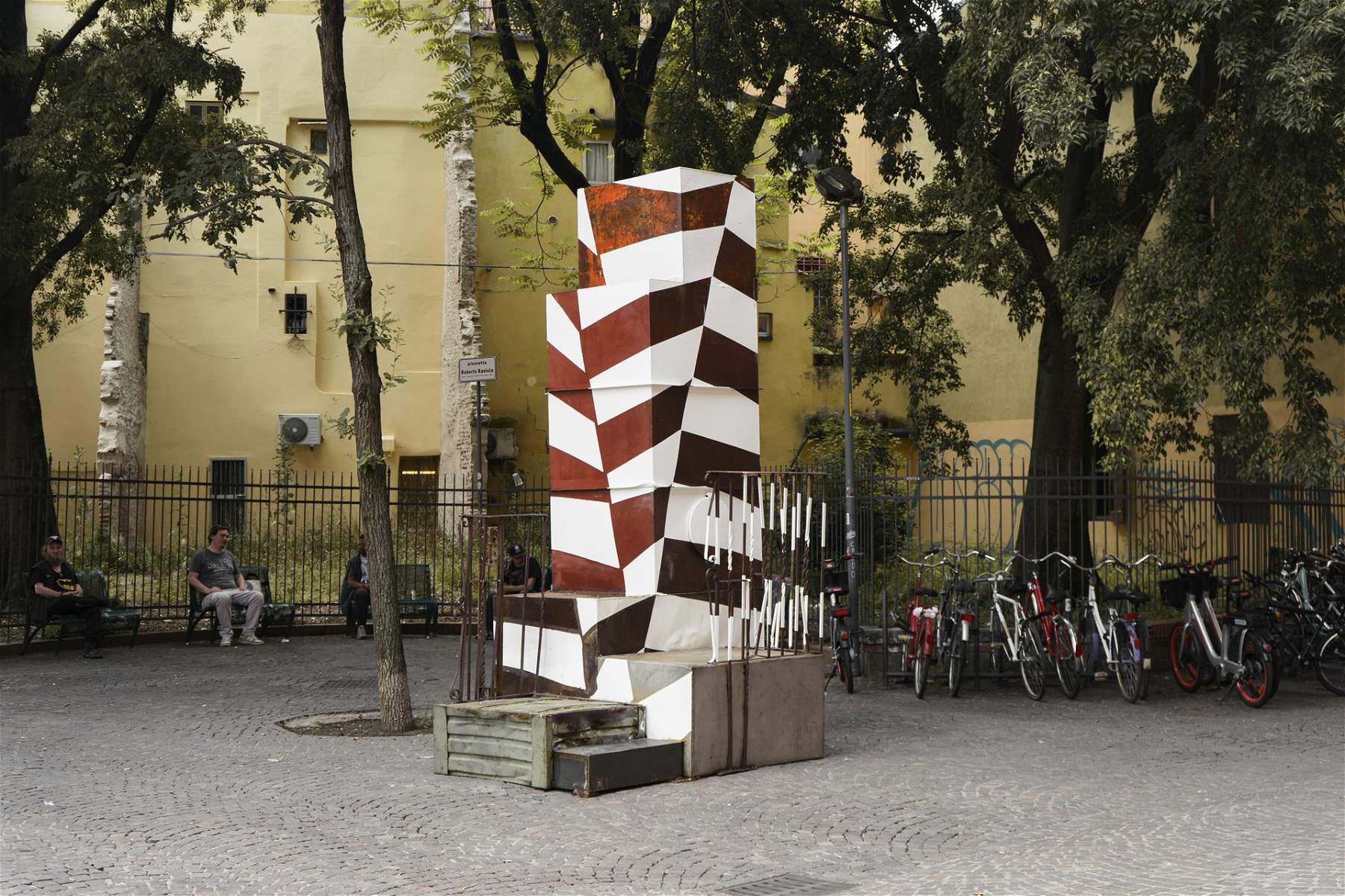Bologna, Flavio Favelli reinvents the concept of the pulpit with his new public work
In Bologna, starting Wednesday, June 7, near theAcademy of Fine Arts of Bologna, it will be possible to see a new, large site-specific sculpture by Flavio Favelli (Florence, 1967), installed in Piazza Roberto Raviola: it is Pulpit and Other Figures, an iron sheet metal work created as part of riparAzioni, a cultural project conceived by the Academy for PON Metro 14-20, National Operational Program Metropolitan Cities, coordinated by the City of Bologna and funded by the European Union.
Made by Favelli with industrial components and disused street furniture, such as cisterns and wrought iron balustrades, the work aims to reinvent the public concept of the pulpit, articulating itself in a series of “stages” of different heights and sizes on which it is possible to climb and speak freely, facilitating interaction with the surrounding space, the life of the neighborhood and the activities of the Academy. Pulpit and Other Figures reflects on the political and cultural dimensions of places by overturning the monumental hierarchies of the pulpits of the past and transforming art into an active experience capable of updating the historical context and functions of the square. The iron plate elements show and “conceal” themselves from the public thanks to an original optical effect obtained with a painting technique called “Dazzle camouflage,” a particular geometric pattern of white checker-bands painted on the work, employed by the British navy to disguise ships from sighting at sea.
For Favelli, this is the second major public work in Emilia Romagna within a short time: only two years ago, in fact, the Florentine artist had presented in Modena his work Ciro Menotti 1928-1949, a large submarine dedicated to the theme of freedom. The installation of Pulpit and Other Stories was preceded by a workshop led by Favelli and architect Flavio Gardini with a group of students from the Academy’s Departments of Visual Arts and Design and Applied Arts. The coordination of the project and workshop was supervised by Professor Marinella Paderni.
"Pulpit and Other Figures is a new work of public art," said Elena Di Gioia, Delegate for Culture of Bologna and Metropolitan City, “that is embedded in the urban landscape of Piazza Raviola and the university context of Via Zamboni. An area where public speaking out has acted historically if we think of the student movements of then and now, and where the work of Flavio Favelli, among the most important artists of our contemporaneity, proposes an open, public, available and disturbing space to concentrate in the same instant of art two cultural actions, political and public indeed, among the most significant today: Giving voice and at the same time making the city listen to what may emerge from the pulpit. That it is the Academy of Fine Arts in the direction of Cristina Francucci who has developed this project, also tells of how the institution Academy of Fine Arts is opening with new planning more and more to the connection between artistic instances and the city and fully understands the meaning of the projects that as an Administration we have put in place through the European funds PON Metro: to act and create community through the language of art and artistic processes with a great responsibility of the public space.”
Cristina Francucci, Director of the Academy of Fine Arts of Bologna, commented, "Pulpit and Other Figures, placed in front of the Academy of Fine Arts, becomes a symbol of the riparAzioni project, which has among its objectives precisely that of animating a place, Piazza Roberto Raviola, often crossed by situations of great marginality and degradation, returning to the city a renewed inclusive space of sociality and culture. The work declares, with its presence, the importance of giving voice to citizens and citizens to remember, as Gianni Rodari said the beautiful democratic sound of the motto ’All uses of the word to all,’ not so that everyone is an artist, but so that no one is a slave."
“The pictorial motif on the tower pylon used on World War I ships refers to the relationship between art and war, two eternal and indispensable subjects of humankind,” Favelli concludes. “This checkmate motif, beyond its meanings, appears formally as a somewhat abstract presence. And this is a crucial point of the work: to give an other, different sign, which escapes from the more obvious and obvious side of reality, without any relation to the context, to the territory.”
 |
| Bologna, Flavio Favelli reinvents the concept of the pulpit with his new public work |
Warning: the translation into English of the original Italian article was created using automatic tools. We undertake to review all articles, but we do not guarantee the total absence of inaccuracies in the translation due to the program. You can find the original by clicking on the ITA button. If you find any mistake,please contact us.



























